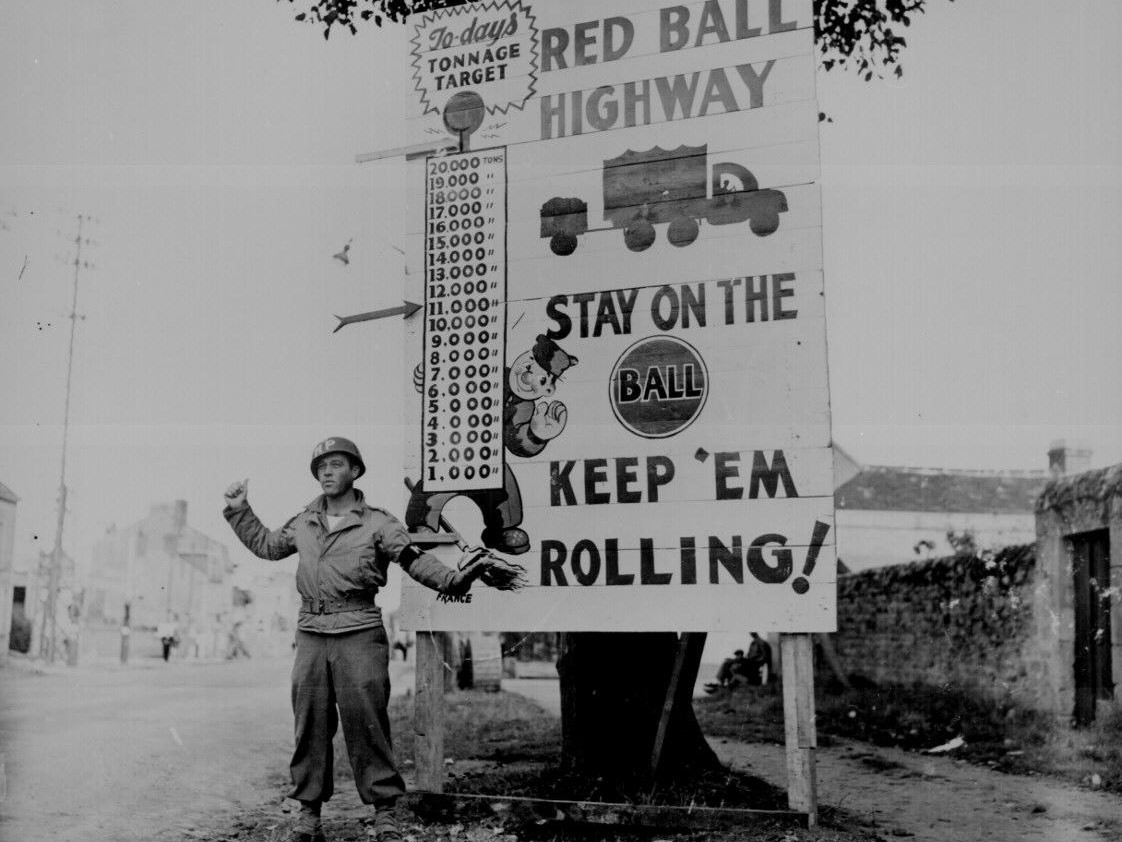The success of the Allies in the liberation of Western Europe was made possible by the men who helped bring supplies to the front line, such as the personnel of the Red Ball Express. The Red Ball Express was a truck convoy which supplied US forces between August 25th and November 16th 1944, and which contributed enormously to the success of the armies. The convoy was staffed largely by African-American soldiers, who worked tirelessly to supply the front line.
Following the Normandy landings in July 1944, the Allied forces quickly advanced into France, but their progress depended heavily on access to supplies. The French railway system had been severely damaged during the conflict and the Allies had not yet gained access to crucial ports in France and Belgium. The Red Ball Express was conceived as a temporary solution to the supply dilemma. The convoy name was derived from a rail term meaning to prioritise. The route was intended as a one-way express loop highway, and the supply trucks were meant to have exclusive use of the route. It was signposted with red balls and warning signs for other vehicles to stay off the highway, although other military and civilian vehicles often disregarded this, causing disruptions and delays.
The original routes ran from Cherbourg to Chartres, bringing supplies to General George S. Patton’s Third Army and the US First Army. The routes were later extended as far as Sommesous and Soissons. Within days of being operational the convoy reached its peak in terms of supply, delivering over 12,000 tons of supplies and using close to 6,000 trucks. The urgency of supplying the front line meant that the convoys ran twenty-four hours a day. Driving at night proved difficult, as the truck headlights needed to be masked with ‘cat-eye’ covers to prevent the convoys from being detected and attacked by German planes. Truck drivers also had to contend with landmines and snipers, as well as shrapnel and barbed wire, which shredded tires. Simple fatigue was also an issue for the drivers who often worked more than twenty-four hours at a time.
The Red Ball Express was discontinued in mid November when more efficient means of transporting supplies became possible. In expressing his gratitude to the supply convoys in October 1944, Supreme Commander General Dwight Eisenhower described the Red Ball Express route as “the lifeline between combat and supply [...] without which the armies might fail.” During the brief 83-day lifespan of the Red Ball Express, the convoy had transported more than 400,000 tons of supplies to the front line using around six thousand trucks. Around 23,000 men had worked on the route, 75% of whom were African-American. Racial policy in the US dictated the number of African-American recruits in the armed forces, and they accounted for a mere 8% of US troops stationed in Europe throughout the war. While a proportion of these troops took up combat roles, the majority of African American soldiers were assigned to service roles such as the Red Ball Express.
Sources:
Bykofsky, Joseph and Harold Larson. The Transportation Corps: Overseas Operations. Washington D.C. Office of the Chief of Military History, 1957.
Lee, Ulysses. The Employment of Negro Troops: The United States Army in WWII. Washington D.C. Office of the Chief of Military History, 1966.
Makamson, Collin. “Keep em Rolling.” 2012. The National WWII Museum New Orleans. Accessed March 19, 2019. http://www.nww2m.com/2012/02/keep-em-rolling/.
Medford, Edna Green and Michael Frazier. 1993. "Keep 'em Rolling”: African American Participation in the Red Ball Express.” Negro History Bulletin 51 (1): 57-61.
Olmsted, Daniel. “From the Pony Express to the Red Ball Express.” 2018. The National World War II Museum New Orleans. Accessed March 19, 2019. https://www.nationalww2museum.org/war/articles/pony-express-red-ball-express.
Ruppenthal, Roland G. Logistical Support of the Armies: The European Theatre of Operations. 2 Vols. Washington D.C. Office of the Chief of Military History, 1953. US Army Transportation Museum. “The Red Ball Express, 1944.” Accessed March 19, 2019. https://web.archive.org/web/20180126045735/http://www.transchool.lee.army.mil:80/museum/transportation%20museum/redballintro.htm.
Wynn, Neil A. The African-American Experience during World War II. Plymouth: Rowman and Littlefield Publishers, 2010.
